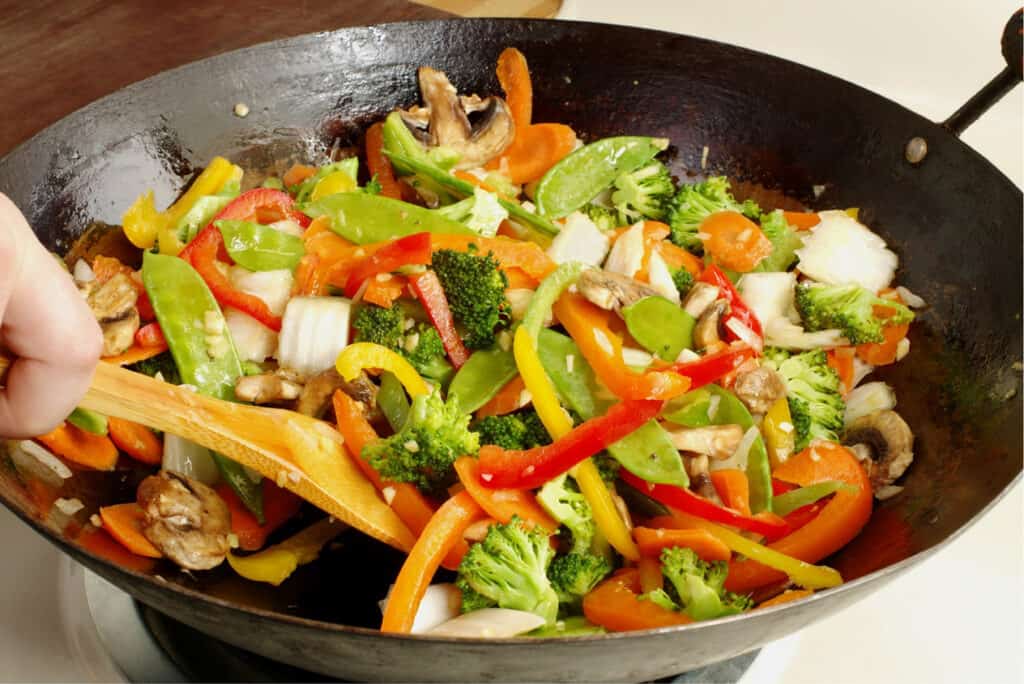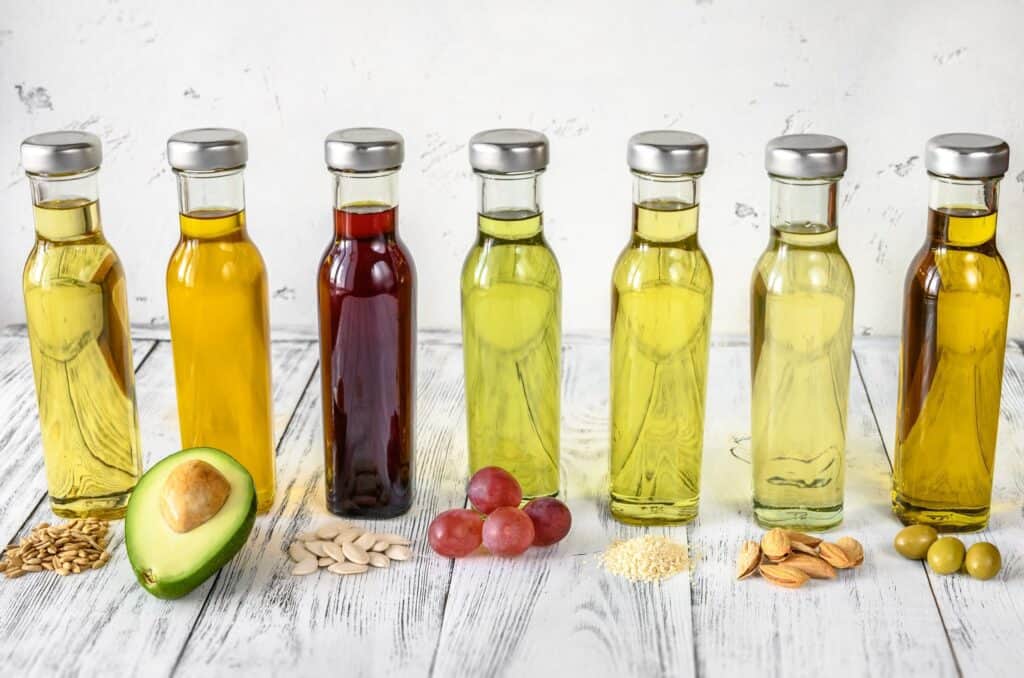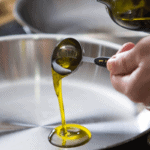As well as many other cuisines, stir-frying is a common technique…
…in Chinese cooking. A good stir-fry requires a very high cooking temperature…
…so that the food will cook quickly.
Let me tell you why…
The stir-frying oils should have a high smoke point…
…since it involves high heat. The oil will burn if you don’t…
…and the dish will be ruined. If heated to its smoke point or higher…
…oil will actually start smoking and will impart a bitter taste to the food.
Molecular breakdown of the oil can cause it to produce carcinogens…
…which are bad for you.
Brian would like to share something…
So, I’m satisfied that extra-virgin olive oil…
..is suitable for most of my cooking preparations….
However, it’s not great for stir-frying oils- neither in the flavour..
…nor in the fact that it smokes too much for my comfort level.
I’m not sure if it is my technique or the oil…
There are so many options for stir-frying oils…
…I got lucky I found the one suit me on my first time. I use canola oil now.
Canola oil production involves high heat and exposure to chemicals. Considered a chemically refined oil, canola goes through stages — such as bleaching and deodorizing — that involve chemical treatment
healthline.com
Now her we go…..
Highest Smoke Point Stir-Frying Oils
As a rule, Chinese cooks use soybean oil, vegetable oil…
…or peanut oil, all of which have a high smoke point.
Peanut oil usually has a pleasant nutty taste…
…and can be used for stir-frying oils as well as deep-frying.
Canola oil, with its high smoke point and neutral flavor…
…is also an excellent alternative. Corn, soybean…
…and extra virgin coconut oil are other types of oil you can use.
You should use an oil that has a smoking point above 400 F, such as:
Canola oil: 400 F/204 C
In addition to its high monounsaturated fat content…
…canola oil also contains a decent amount of polyunsaturated fats.
Canola oil is extracted from rapeseeds, a flowering plant….
Canola oil tends to have the least amount of saturated fats of all vegetable oils…
As a result of its high smoke point…
..it can be used for cooking at high temperatures.
However, canola oil tends to be highly processed in the United States…
..which means that it contains fewer nutrients.
Cold-pressed or unprocessed canola oil is available…
…but it can be difficult to locate.
- 128 fluid ounces of Happy Belly Canola Oil. Packaging may vary
- Add versatility in your kitchen with this light tasting Canola oil
- Great for cooking and frying
- A cholesterol free food, contains 14g total fat per serving. See nutrition information for fat and saturated fat content
- 0g Trans fats per serving. See nutrition information for fat and saturated fat content
- Any oil will burn if overheated. Do not leave unattended while heating.
- If oil smokes, reduce heat. If fire occurs, turn off heat and cover until cool. Do not put water on hot or flaming oil and do not pour hot oil back in the container. Damage can occur, causing injury
- If you like Crisco canola oil, we invite you to try Happy Belly canola oil
- Satisfaction Guarantee: Were proud of our products. If you arent satisfied, well refund you for any reason within a year of purchase. 1-877-485-0385
- An Amazon brand
Prices pulled from the Amazon Product Advertising API on:
Product prices and availability are accurate as of the date/time indicated and are subject to change. Any price and availability information displayed on [relevant Amazon Site(s), as applicable] at the time of purchase will apply to the purchase of this product.
Coconut oil (refined): 450F/232 C
You can either avoid coconut oil or embrace it in moderation…
…depending on who you ask. A major point of contention is…
…the high saturated fat content of coconut oil; unlike other plant-derived oils…
…coconut oil mainly consists of saturated fats.
Although not everybody agrees that saturated fat is bad for health…
…some experts, including the American Heart Association…
…argue that replacing foods rich in saturated fat with healthier….
…alternatives can lower blood cholesterol levels and improve lipid profiles.
- NATURALLY EXTRACTED and NUTRIENT DENSE: Nutiva’s all-natural cold press extraction process yields a pure, light-tasting, nutrient-rich oil containing 63% medium chain triglycerides and 50% lauric acid without the use of dangerous and harmful chemicals, hexane, or heat
- PREMIUM DIET COMPATIBILITY: Nutiva Virgin Coconut Oil is an ideal addition to vegetarian, vegan, raw, whole food, paleo, ketogenic, and gluten-free diets
- HEALTH AND BEAUTY: Nutiva Virgin Coconut Oil has natural moisturizing and deep conditioning properties, making it an invaluable part of every body care regimen
- COMMITMENT TO QUALITY: Nutiva partners with organic farmers to source the world’s finest fresh, organic virgin coconuts and stringently adheres to USDA certified organic and non-GMO guidelines to deliver superfood that is good for you and good for the planet
- EASY TO USE PACKAGING: Nutiva Virgin Coconut Oil is packaged in safe, convenient, BPA-free packag
Prices pulled from the Amazon Product Advertising API on:
Product prices and availability are accurate as of the date/time indicated and are subject to change. Any price and availability information displayed on [relevant Amazon Site(s), as applicable] at the time of purchase will apply to the purchase of this product.
Corn oil: 450 F/232 C
- One 128-fluid ounce (1 gallon) bottle of Happy Belly Corn Oil
- Great for cooking and frying
- A light tasting oil made from Corn
- 0g trans fat per serving
- About 256 servings per container (serving size of 1 tablespoon)
- Satisfaction Guarantee: Were proud of our products. If you arent satisfied, well refund you for any reason within a year of purchase. 1-877-485-0385
- An Amazon br
Prices pulled from the Amazon Product Advertising API on:
Product prices and availability are accurate as of the date/time indicated and are subject to change. Any price and availability information displayed on [relevant Amazon Site(s), as applicable] at the time of purchase will apply to the purchase of this product.
Grapeseed oil: 420 F/215 C
- crafted from grapes imported from France
- High smoke point ideal for stir-frying, deep frying, sautéing and baking
- Rich source of Vitamin E, fatty acids and Omega 7
- crafted with the same passion, dedication and expertise as Pompeian olive oils
- Quality since 1906 from the Olive Oil Peo
Prices pulled from the Amazon Product Advertising API on:
Product prices and availability are accurate as of the date/time indicated and are subject to change. Any price and availability information displayed on [relevant Amazon Site(s), as applicable] at the time of purchase will apply to the purchase of this product.
Olive oil (light/refined): 465 F/240 C
As long as it is extra virgin olive oil, nutrition and cooking experts agree…
..that it is one of the most versatile and healthy oils to cook with and eat.
“You want an oil that is not refined or overprocessed,” says Howard…
Olive oil that is labeled “extra virgin” means that it has not been refined…
…and is therefore of high quality. Extra virgin olive oil contains…
,,,a large amount of monounsaturated fats..
..and some polyunsaturated fats;
It has been linked to improved heart health in many studies…
Olive oil has a lower smoke point than most other oils…
…so it’s best for low- and medium-heat cooking
- Farmer-Crafted
- Robust flavor
- Imported, first cold pressed extra virgin olive oil
- Perfect for pasta, marinades and salad dressings. Can also be used for dipping
- Packaging May V
Prices pulled from the Amazon Product Advertising API on:
Product prices and availability are accurate as of the date/time indicated and are subject to change. Any price and availability information displayed on [relevant Amazon Site(s), as applicable] at the time of purchase will apply to the purchase of this product.
Peanut oil: 450 F/232 C
Peanut oils can be fun to experiment with in the kitchen…
…especially since there are so many different types.
One of the highest monounsaturated fat contents…
…among cooking oils is found in peanut oil.
It’s usually flavorful with a nutty taste and smell, and cooks well at high heat…
- One 128-fluid ounce (1 Gallon) bottle of Happy Belly Peanut Oil
- Great for cooking and frying
- 0g trans fat per serving
- About 256 servings per container (serving size of 1 tablespoon)
- Satisfaction Guarantee: Were proud of our products. If you arent satisfied, well refund you for any reason within a year of purchase. 1-877-485-0385
- An Amazon br
Prices pulled from the Amazon Product Advertising API on:
Product prices and availability are accurate as of the date/time indicated and are subject to change. Any price and availability information displayed on [relevant Amazon Site(s), as applicable] at the time of purchase will apply to the purchase of this product.
Rice bran oil: 490 F/254 C
- Rice Bran Oil is one of the healthiest edible oil, rich in vitamins, natural antioxidants, and nutrients. It contains a high level of natural antioxidant, Oryzanol, at 6,000 ppm.
- High smoke point of 445degrees F, making it suitable for the high-temperature cooking methods like pan-frying, stir-frying, sautéing, and deep -frying.
- Rice Bran Oil is a premium choice for those who have an intolerance to other cooking oils.
- Delicate and subtle flavor, excellent for baked goods, salad dressings, and dips.
- Free of Trans Fat and preservativ
Prices pulled from the Amazon Product Advertising API on:
Product prices and availability are accurate as of the date/time indicated and are subject to change. Any price and availability information displayed on [relevant Amazon Site(s), as applicable] at the time of purchase will apply to the purchase of this product.
Safflower oil: 440–510 F/227–265 C
- Naturally expeller pressed oil
- Made without the use of harsh chemicals or solvents, and contains no artificial colors or flavors
- Enriched with Vitamin E, an antioxidant
- Hollywood is a brand committed to producing high quality oils and foods
- Great to use for dressings or low heat cooking; smoke point up to 450 degrees Fahrenh
Prices pulled from the Amazon Product Advertising API on:
Product prices and availability are accurate as of the date/time indicated and are subject to change. Any price and availability information displayed on [relevant Amazon Site(s), as applicable] at the time of purchase will apply to the purchase of this product.
Soybean oil: 450 F/232 C
- HEALTHY COOKING OIL - Bring the best of nature to your table, with our Non-GMO Gourmet Cooking Oil, created without chemicals, hydrogenation or other damaging processing.
- FARM FRESH - Traceable to the farm origin, our Non-GMO Gourmet Cooking Oil is naturally processed, using physical refining methods that ensure inherent, natural antioxidants, Omega fatty acids and Vitamin E are retained.
- NO TRANS-FATS - Our healthy cooking oil lets you enjoy flavorful meals without the harmful impacts that trans-fats can have on your heart, blood sugar and overall health - in fact, it can even help lower cholesterol levels.
- Oil has a longer shelf-life, extended fryer-life and increased flavor stability.
- FOOD WITH INTEGRITY - Healthy Harvest aims to connect responsible eaters with responsible farmers, with sustainability at the heart of everything we do. This is what we call, food with integri
Prices pulled from the Amazon Product Advertising API on:
Product prices and availability are accurate as of the date/time indicated and are subject to change. Any price and availability information displayed on [relevant Amazon Site(s), as applicable] at the time of purchase will apply to the purchase of this product.
Sunflower oil: 440 F/226 C
One tablespoon of this oil has 28% of the recommended daily intake of vitamin E…
Smoke Points are high and it doesn’t have a strong flavor…
…so it will not overpower a dish. A great deal of omega-6 fats…
…are found in sunflower oil. Omega-6 oil is inflammatory…
…while omega-3 oil is anti-inflammatory, so the body needs both.
A high intake of omega-6s without balancing it with omega-3s..
…could lead to excessive inflammation in the body, so moderation is key.
- NATURAL SUNFLOWER OIL - Bring the best of nature to your table, with our Non-GMO healthy cooking oil, created without chemicals, hydrogenation or other damaging processing. The approximate smoke point of our Sunflower oil is 450 degrees.
- AMAZING IN TURKEY FRYERS! - Use the best certified non-gmo oil for your turkey fryer. You are what you eat!
- FARM FRESH - Traceable to farm of origin, our Non-GMO Project Verified Sunflower Oil is naturally processed, using physical refining methods that ensure inherent, natural antioxidants, Omega-3 fatty acids and Vitamin E are retained. NO TRANS-FATS - Enjoy flavorful meals without harmful impacts to your heart, blood sugar and overall health with this healthy cooking oil - in fact, Sunflower Oil can even help reduce your cholesterol.
- LONGER SHELF-LIFE - Our Non-GMO Sunflower Oil has a longer shelf-life, extended fryer-life and increased flavor stability, due to our superior processing methods.
- FOOD WITH INTEGRITY - Healthy Harvest aims to connect responsible eaters with responsible farmers, with sustainability at the heart of everything we do. This is what we call, Òfood with integrit
Prices pulled from the Amazon Product Advertising API on:
Product prices and availability are accurate as of the date/time indicated and are subject to change. Any price and availability information displayed on [relevant Amazon Site(s), as applicable] at the time of purchase will apply to the purchase of this product.
Vegetable oil: 400–450 F/ 204–232 C
The term “vegetable oil” refers to any oil that comes from plants…
…and the healthfulness of a vegetable oil depends on its source and how it’s used.
There are many types of vegetable oils on the market today…
..but most blend corn, soybeans, safflowers, palms, and sunflowers.
“I generally tell people to use olive oil whenever possible rather…
…than corn or soybean oil,” says Weinandy. While they aren’t necessarily…
…bad for you, she says, “you get so much more benefit from olive oil.”…
Vegetable oils are refined and processed, which means…
…they lack flavor but also nutrients, Howard says.
The vegetable oil is guaranteed to be highly processed….
“We call it ‘vegetable’ so that the manufacturers can use…
…whatever commodity oil they want – soy, corn, cottonseed, canola…
…without having to print new labels,” she says.
During processing, some oils have been pushed…
…beyond their heat tolerance and have become rancid.
Some of these oils, particularly palm, are associated…
…with more degradation of land.
- 128 fluid ounces of Happy Belly Vegetable Oil. Packaging may vary
- This light tasting oil is made from soybeans
- Great for cooking and frying
- A cholesterol free food, contains 14g total fat per serving. See nutrition information for fat and saturated fat content
- 0g Trans fats per serving. See nutrition information for fat and saturated fat content
- Any oil will burn if overheated. Do not leave unattended while heating
- If oil smokes, reduce heat. If fire occurs, turn off heat and cover until cool. Do not put water on hot or flaming oil and do not pour hot oil back in the container. Damage can occur, causing injury
- If you like Crisco vegetable oil, we invite you to try Happy Belly vegetable oil
- Satisfaction Guarantee: Were proud of our products. If you arent satisfied, well refund you for any reason within a year of purchase. 1-877-485-0385
- An Amazon br
Prices pulled from the Amazon Product Advertising API on:
Product prices and availability are accurate as of the date/time indicated and are subject to change. Any price and availability information displayed on [relevant Amazon Site(s), as applicable] at the time of purchase will apply to the purchase of this product.
Even though you may not think about it, you can cook stir-fries…
…with light or refined olive oil. It is not the same as extra virgin olive oil…
Extra virgin olive oil has a very low smoke point and a very strong flavor…
…making it unsuitable for stir-frying oils.
Grapeseed oil, made from the seeds of grapes after the wine has been pressed…
…is becoming increasingly popular.
The health benefits of this oil are similar to those of olive oil…
…but with a more neutral flavor. It has a high smoke point (420 F/215 C)…
…a clean flavor, and a high smoke point.
If you are looking for best oil for stir-fry that perfect for you…
…we have some recommendations.

Stir-frying Oils That Are Healthy
Olive oil and canola oil both contain high levels of…
…monounsaturated fats and low amounts of saturated fat.
Monounsaturated fats are believed to reduce bad cholesterol (LDL)…
…which can block arteries and lead to heart disease and strokes.
They also increase the amount of good cholesterol (HDL)…
…that removes cholesterol buildup in the arteries.
Scientists believe grapeseed oil can also help raise HDL levels…
…because it is low in saturated fat and high in polyunsaturated fat.
Also a good source of linoleic acid is grapeseed oil…
Unlike omega-3 fatty acids found in salmon…
…that type of fatty acid can’t be made by our bodies…
…and must be obtained from food.

Stir-frying Oils to Avoid
In addition to extra-virgin olive oil, there are other…
…oils with low smoke points that should be avoided.
For instance, sesame oil has a very low smoke point….
Despite the fact that some Chinese dishes use toasted sesame oil…
…to fry the ingredients, such as three cup chicken, it is not recommended…
…for high-heat cooking. When you heat sesame oil in a wok…
…be careful not to burn it. Be careful not to overheat it…
…or else it will burn and make your dish taste bitter.
In Chinese cooking, sesame oil is usually only used for seasoning…
…or for adding to stir-fry dishes at the end of cooking.
Furthermore, avoid using flaxseed oil and butter or shortening when stir-frying…
Sum Up
There are many type of stir-frying oils you can choose ..
Like olive oil, canola oil, vegetable oil, peanut oil, etc…
You just need to choose which stir-frying oils suit you the most…
Conclusion
Those are the stir-frying oils you can choose…
Does this article help you to choose which stir-frying oils?
Or do you have any experience with stir-frying oils?
Leave a comment or contact us..
If you have more questions about stir-frying oils!
Was this helpful?
Hi there! I’m a food enthusiast and journalist, and I have a real passion for food that goes beyond the kitchen. I love my dream job and I’m lucky enough to be able to share my knowledge with readers of several large media outlets. My specialty is writing engaging food-related content, and I take pride in being able to connect with my audience. I’m known for my creativity in the kitchen, and I’m confident that I can be the perfect guide for anyone looking to take their culinary journey to the next level.


















